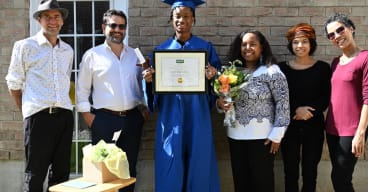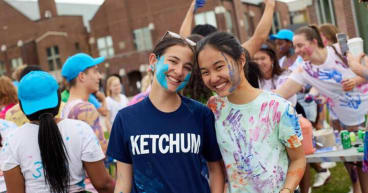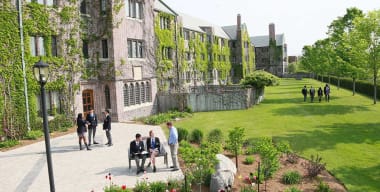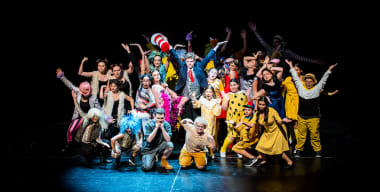Instead, Christian found a safety net in the form of his classmates' support. Their words of encouragement, combined with their steady grip on several tension lines, helped Christian master the test of balance, strength and stamina--and his fear of heights.

"A little slower, Christian. You can do it," called one student. "Don't look down," added another, as Christian inched his way across the course. With help from his assigned partner and their friends far below, Christian made it across the thick tightrope.
"It was scary, but I'm glad I did it," recalls Christian, now a first-year student at McGill University in Montreal. "It felt good to know that I could do it. And I knew the guys were there for me the whole time."
Soon after Christian's sky-high adventure, I made my own pilgrimage to the Norval Outdoor School, a 400-acre education centre near Georgetown, Ontario, northwest of Toronto.
UCC bought the property in 1913, initially with plans to relocate our Toronto-based boys' school to more rural surroundings. But, when the First World War hit, plans to move UCC halted, and the Norval property became a place where students and others could focus on environmental programs.
Nowadays, almost 1,000 students, teachers and UCC staff members visit the facility each year to learn about their natural surroundings and how to care for our fragile planet. On occasion, visitors from other independent schools benefit from the property, too.
Norval provides different opportunities with the changing season. For example, in early spring, students tap trees and make maple syrup in the on-site sugar shack. They raise bees in hives and collect honey. Some learn how to recognize different species of trees and identify bird calls. They also help stock salmon in the Credit River, which runs through the picturesque property.
A few years ago, students helped to build a small log cabin on the property, and their contemporaries are now learning about the solar power used in the cabin.
When they're not studying the natural environment--or sometimes while they're studying the environment--students also learn about teamwork and leadership through a variety of exercises, including the high ropes.
My department, UCC's Office of Advancement, visits Norval yearly to experience this beautiful resource. While communing with nature, we also learn about group dynamics, leadership and stretching personal boundaries--lessons similar to those reaped by our students on their trips to the centre. Each activity we explore presents different physical and psychological challenges.
While nerve-wracking for some, the high ropes challenge is well constructed and quite safe, assures Bill Elgie, director of the Norval Outdoor School. All participants wear rock-climbing harnesses and helmets, and climbers are connected by a strong rope to "belay teams" on the ground, who keep the line tight between themselves and the climber. These belayers are under the constant supervision of adults who are experts in the course.
Like Christian, I have a fear of heights. Luckily, I've managed to avoid the high ropes on each of my three visits to Norval. The thought of climbing a 30-foot telephone pole to navigate a tightrope leaves me feeling like a character from Hitchcock's Vertigo: clammy, pale and dizzy.
So Norval's low ropes, on which individuals hover only a few feet above the ground, is more my speed. Though on my latest Norval trip, I kept my feet firmly planted on the ground as part of a team. Working with a second team, we helped a colleague strapped into a harness swing along the ropes course like Peter Pan.
Later, I also managed to avoid the chance to free-fall backward from a four-foot-high platform into the interlaced arms of a dozen co-workers. One at a time, several people stepped up to the platform and showed their utmost trust for colleagues as they dropped into waiting arms. Throughout this exercise, I was a constant "catcher," hell-bent on ensuring a safe landing for each and every brave soul who took the plunge. In fact, I was terrified that I would drop one of my colleagues, a six-foot-tall man of sturdy girth. The lesson I had to learn in this exercise was that this man's safety didn't rest solely in my hands--I was part of a team that could, together, ensure his safe landing. A
t Norval, I haven't yet conquered the high or low ropes, nor have I mastered the heights of the free-fall platform or the marine-inspired climbing wall. Routinely, I've found that my personal challenges at Norval are closer to the ground.
In one exercise, I worked with a team as we pretended to transport a "radioactive egg" across a "lava field." Okay, it was just a regular chicken egg that we moved through the forest, but we were motivated. We had to strategize, assign tasks and coach each other as we moved gingerly across a narrow pathway of boards that ran through the imaginary lava. Each time someone faltered, the one who followed learned a lesson and earlier mistakes could be avoided.
In another challenge, we encountered a giant geodesic form made of plastic tubing, open on all faces, which sat precariously on one corner atop a plastic stand. One at a time, we had to travel through the form without tipping it from its perch--without repeating the route of any co-worker who went before us. Again, we needed a strategy: Tall workers stepped up and over the lower bars; shorter workers crawled through the lower openings, or relied on taller colleagues to lift them through the higher openings. At one point, I became a human stepladder as a petite colleague climbed onto my back to reach the opening she needed to step through. To reach our collective goal in exercises such as this, we entered the "personal space" of others and watched as personal barriers fell.
In another exercise, a rubber ball rested on a ring that was connected to several lengths of string. Each participant was told to grab a string and, in a co-ordinated effort, lift the apparatus from the ground and move it across the grass without dropping the ball. We had an instant lesson in teamwork: If one person moved too quickly, the apparatus tipped. Everyone had to move at the same pace, in the same direction. Planning, group co-operation and steady nerves came into play as we searched for the fastest, most efficient way to get the job done.
From their outdoor education experience, it's clear that many people take away lessons they can apply in the classroom, the workplace and at home. As we worked to solve problems under tight time constraints, different personalities took centre stage. Strategic thinkers, task masters, helpers, cheerleaders, comedians and supportive counsellors emerged from our midst. Throughout such Norval exercises, normally shy, quiet individuals turned into assertive commanders, while workplace managers felt comfortable watching others lead. Some discovered engineering and spatial skills they didn't know existed. And some, such as student Christian Peterson, even faced their phobias.
Elgie points out that many of Norval's games and challenges can be replicated in urban environments, or even indoors. But he finds the lessons of the outdoors can be most profound. He believes there's "a calming effect of being in natural surroundings that makes people more open to the kinds of experiences that we offer." Outdoor education often takes people out of their usual context, and that's when they can really learn, he says.
Of course, the great outdoors can also be the ideal classroom for learning about nature and sustainability. Elgie believes that some of the best environmental learning happens when you're not saying, "Class, it's time for environmental learning." It's when you come across a newborn fawn or hold a tiny field mouse in your hand.
When I visit our outdoor education gem, I always marvel at the beauty of the seasons and the wildlife I encounter. But I've taken away many other great experiences from my Norval visits, and used skills that I didn't know I had.
Norval reaffirms the fact that, when it comes to vertical challenges, I'm not a daredevil -- yet. But there's always next year for the high ropes courses.










